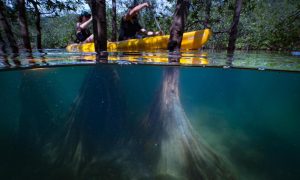Carbon Sequestration
 Credit Carbon Brief
Credit Carbon Brief
There is a scientific consensus that tree and foliage coverage sequesters carbon and reduces the carbon print brought on by burning of fossil fuels. Afforestation is a climate mitigation tool. Trees can store carbon for decades if not longer. Theoretically planting one trillion trees would reduce global warming trend by almost 25 %. Reforestation is a vital element in absorbing carbon.Restoring wetlands and conserving mangrove swamps on the coast is the best solution towards preventing climate change.
In the year 2023 global CO2 emissions peaked at 37.01 billion tons. Felling trees and forests only to replant them is not a sustainable solution as planting trees alone won’t offset the damage .In order to absorb carbon emissions of this magnitude we need to plant 1.48 trillion trees requiring land the size of the entire USA (925M hectares). Efforts must be directed towards reducing emissions at source while embracing innovation to absorb CO2 existing in the air. Pakistan clearly lacks the capacity to embark on any such initiative despite frequenting conferences.
Mangroves Store more Carbon

Conservation of mangroves is significant as the muddy and water laden roots of mangroves and halophytic trees can store four times the amount of carbon which a tropical forest can. Mangroves and salt marshes are also known as Blue Carbon sinks. Mangroves are coastal forests and it is integral in the crusade against global warming to prevent coastal degradation and promote conservation of mangrove forests which will also preserve the habitat and ecosystems of endangered marine species as well.
 Credit Bon Pote
Credit Bon Pote
Carbon fixed by vegetated coastal ecosystems , mainly mangrove forests, is known as ” Blue Carbon “. The UN’s Intergovernmental Panel on Climate Change various reports highlight that afforestation of 2.3 billion acres can restrict the increase in global average temperature to 1.5-degrees Celsius above pre-industrial levels by the year 2050.

Leave A Comment